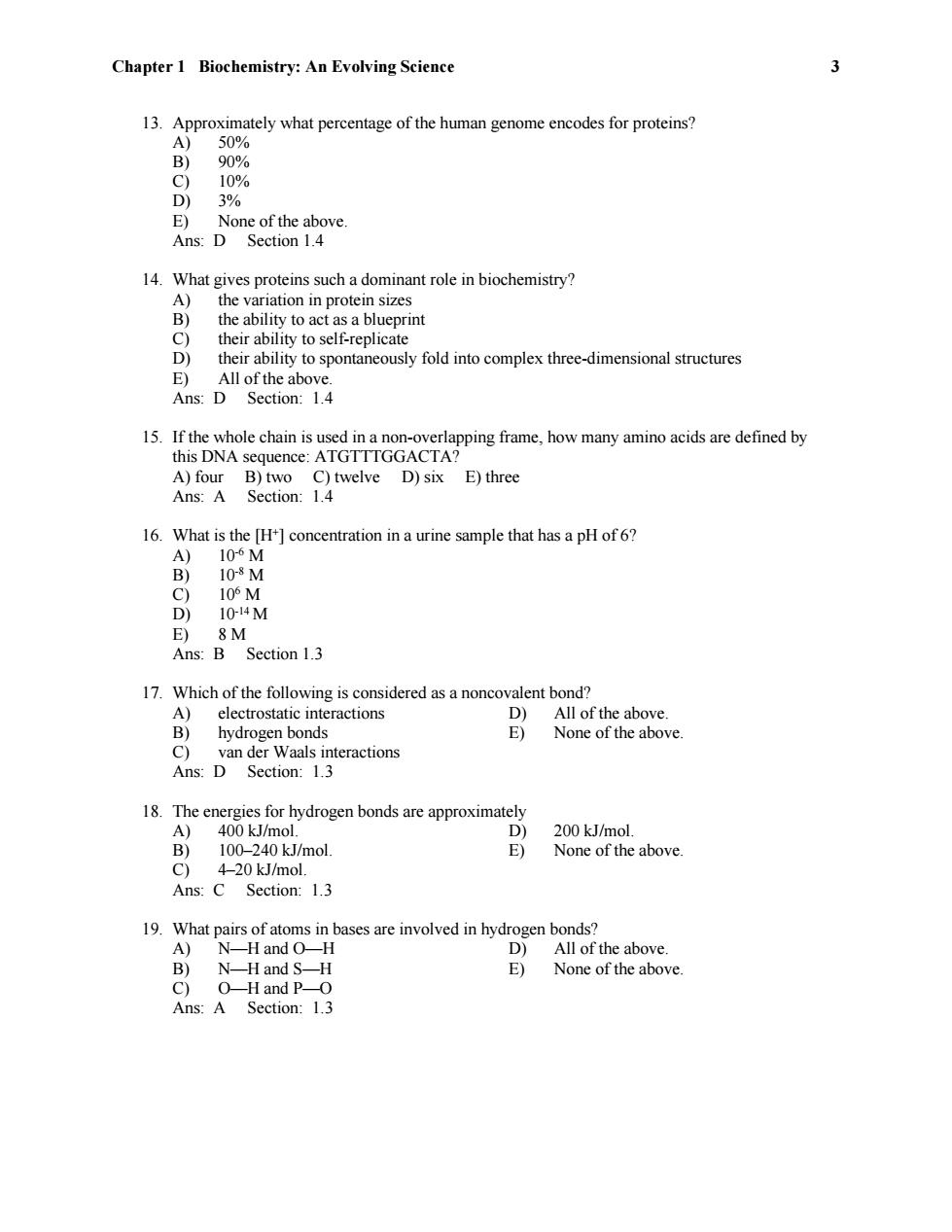正在加载图片...

Chapter 1 Biochemistry:An Evolving Science 13.Approximately what percentage of the human genome encodes for proteins? A) 50% B) 90% c) 10% D 3% E)None of the above Ans:D Section 1.4 14.What gives proteins such a dominant role in biochemistry? A)the variation in protein sizes B) the ability to act as a blueprint C)their ability to self-replicate D)their ability to spontaneously fold into complex three-dimensional structures E)All of the above. Ans:D Section:1.4 15.If the whole chain is used in a non-overlapping frame,how many amino acids are defined by this DNA sequence:ATGTTTGGACTA? A)four B)two C)twelve D)six E)three Ans:A Section:1.4 16.What is the H+]concentration in a urine sample that has a pH of 6? A)10-6M B) 10-8M C) 10°M D)10-14M E)8M Ans:B Section 1.3 17.Which of the following is considered as a noncovalent bond? A) electrostatic interactions D) All of the above. B) hydrogen bonds E) None of the above. C) van der Waals interactions Ans:D Section:1.3 18.The energies for hydrogen bonds are approximately A)400 kJ/mol. D 200 kJ/mol. B)100-240kJ/mol E) None of the above C)4-20 kJ/mol. Ans:C Section:1.3 19.What pairs of atoms in bases are involved in hydrogen bonds? A)N-H and O-H D) All of the above. B)N-H and S-H E) None of the above. C)O-H and P-O Ans:A Section:1.3Chapter 1 Biochemistry: An Evolving Science 3 13. Approximately what percentage of the human genome encodes for proteins? A) 50% B) 90% C) 10% D) 3% E) None of the above. Ans: D Section 1.4 14. What gives proteins such a dominant role in biochemistry? A) the variation in protein sizes B) the ability to act as a blueprint C) their ability to self-replicate D) their ability to spontaneously fold into complex three-dimensional structures E) All of the above. Ans: D Section: 1.4 15. If the whole chain is used in a non-overlapping frame, how many amino acids are defined by this DNA sequence: ATGTTTGGACTA? A) four B) two C) twelve D) six E) three Ans: A Section: 1.4 16. What is the [H+ ] concentration in a urine sample that has a pH of 6? A) 10 -6 M B) 10 -8 M C) 10 6 M D) 10 -14 M E) 8 M Ans: B Section 1.3 17. Which of the following is considered as a noncovalent bond? A) electrostatic interactions D) All of the above. B) hydrogen bonds E) None of the above. C) van der Waals interactions Ans: D Section: 1.3 18. The energies for hydrogen bonds are approximately A) 400 kJ/mol. D) 200 kJ/mol. B) 100–240 kJ/mol. E) None of the above. C) 4–20 kJ/mol. Ans: C Section: 1.3 19. What pairs of atoms in bases are involved in hydrogen bonds? A) N—H and O—H D) All of the above. B) N—H and S—H E) None of the above. C) O—H and P—O Ans: A Section: 1.3